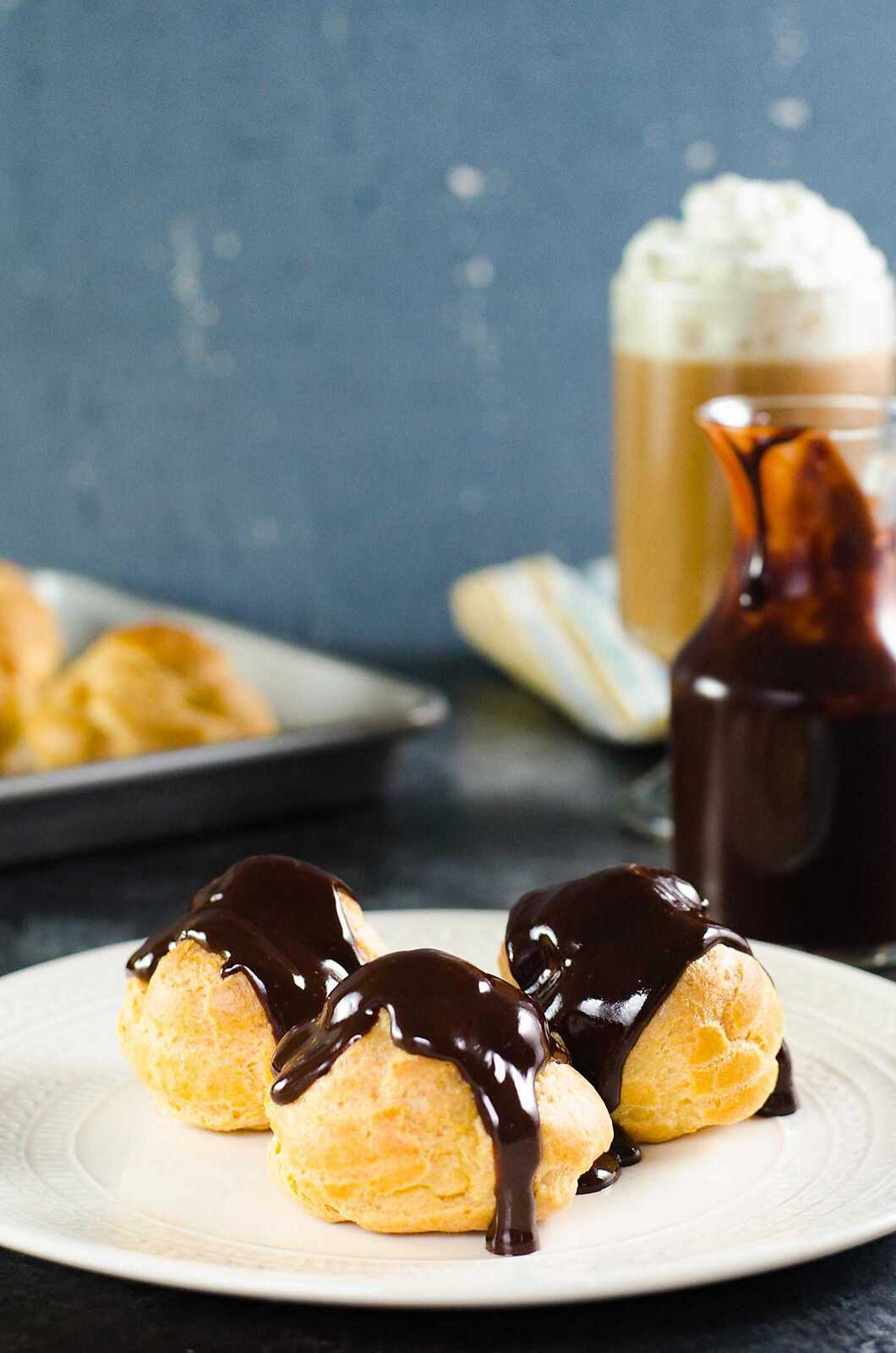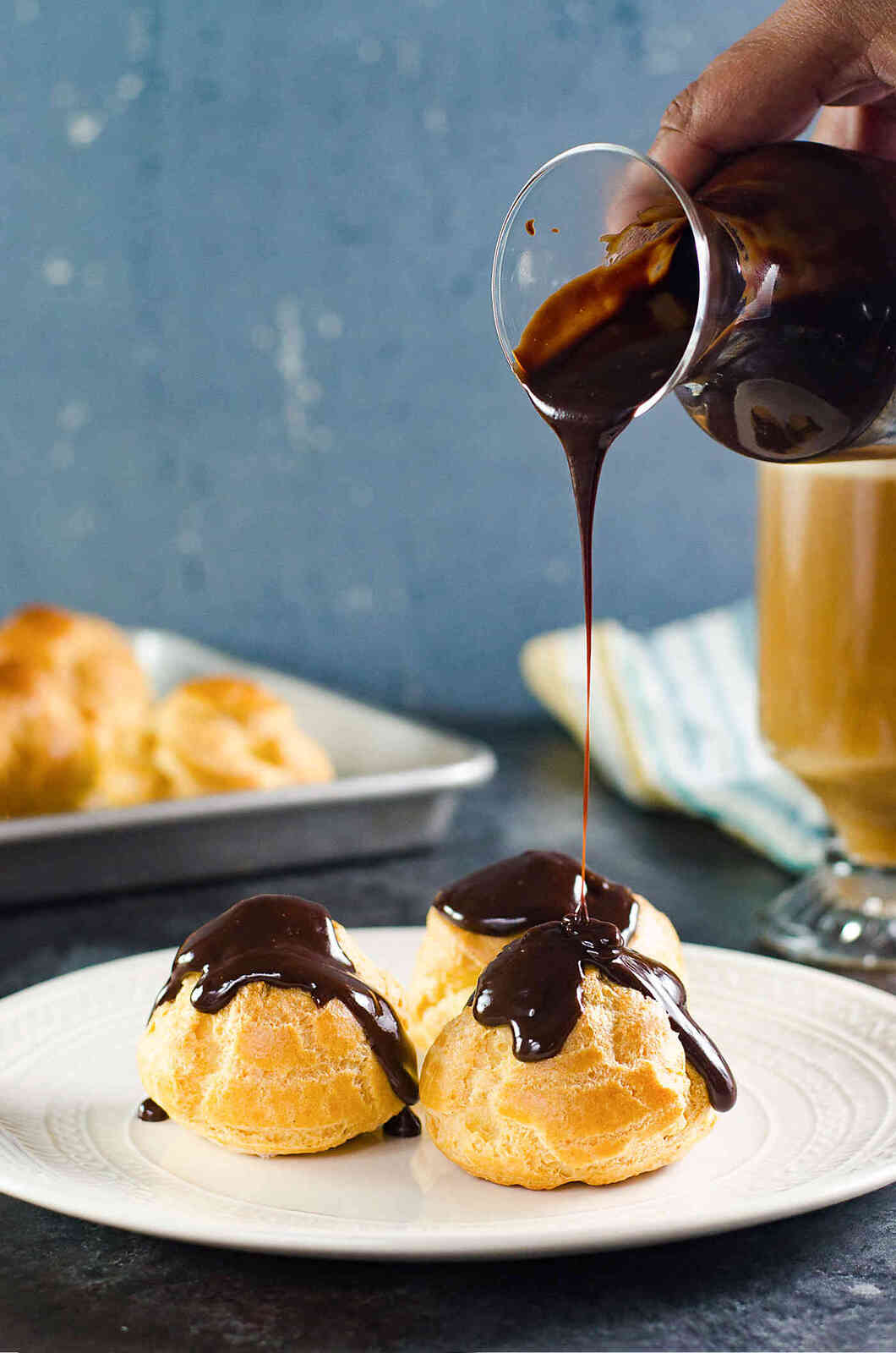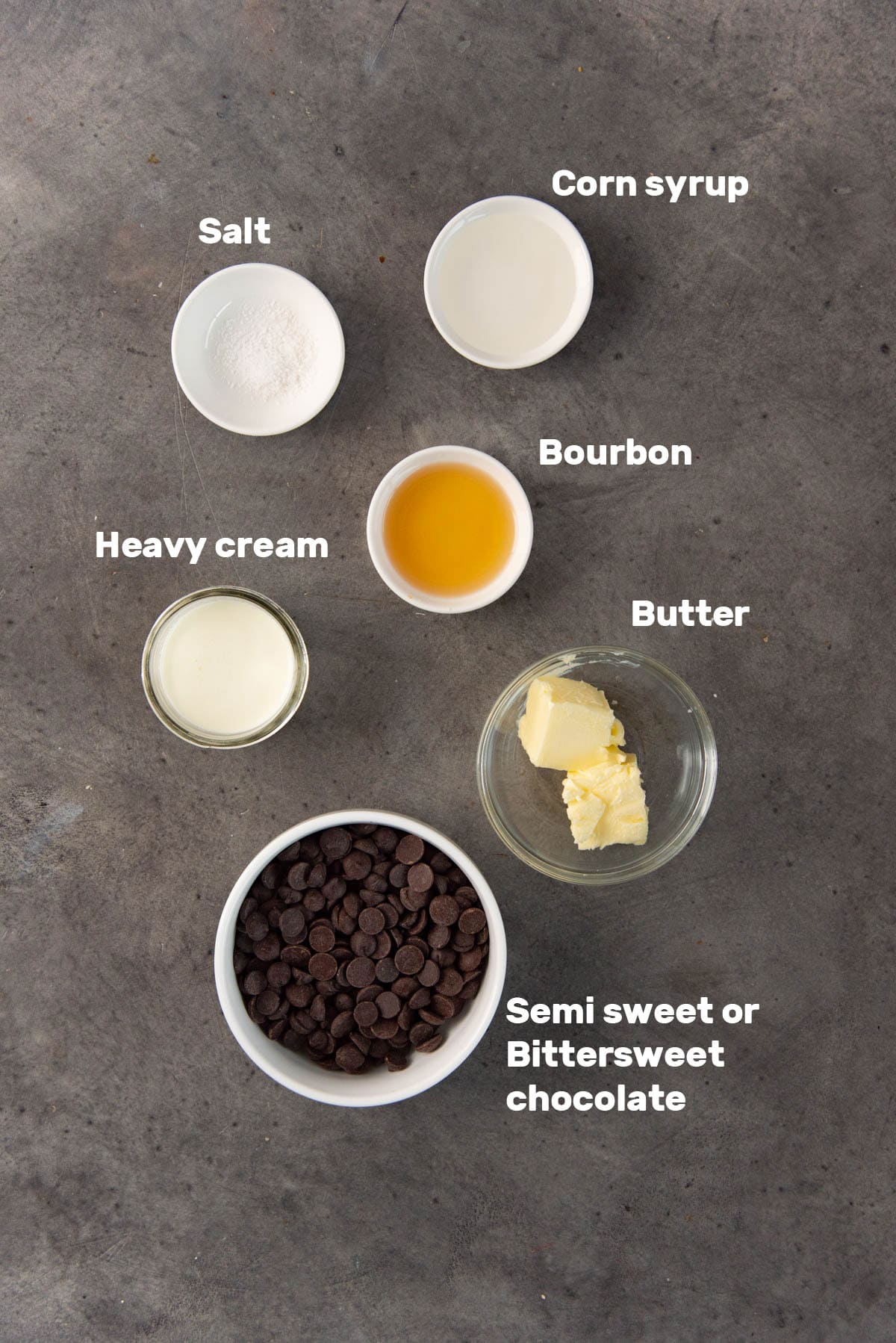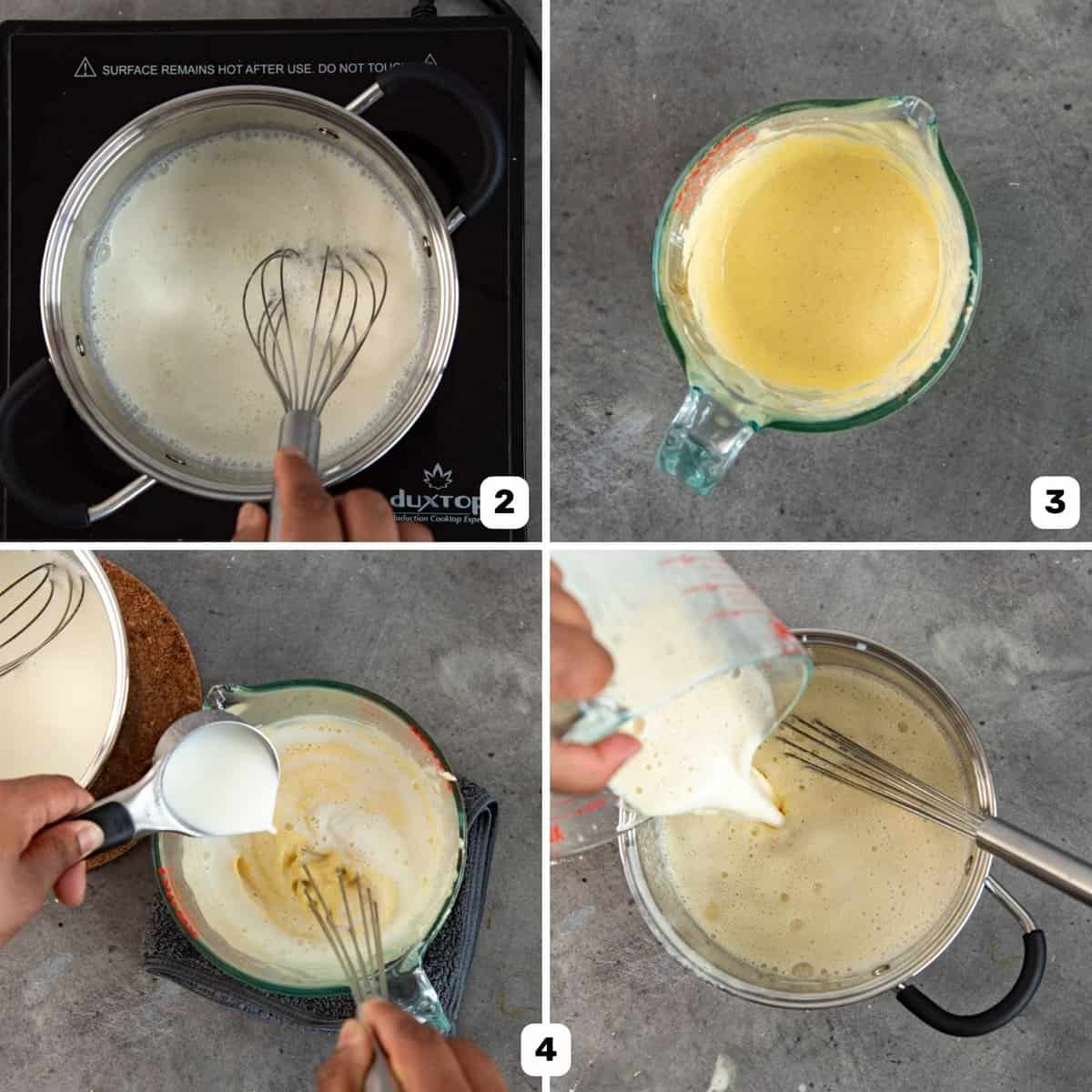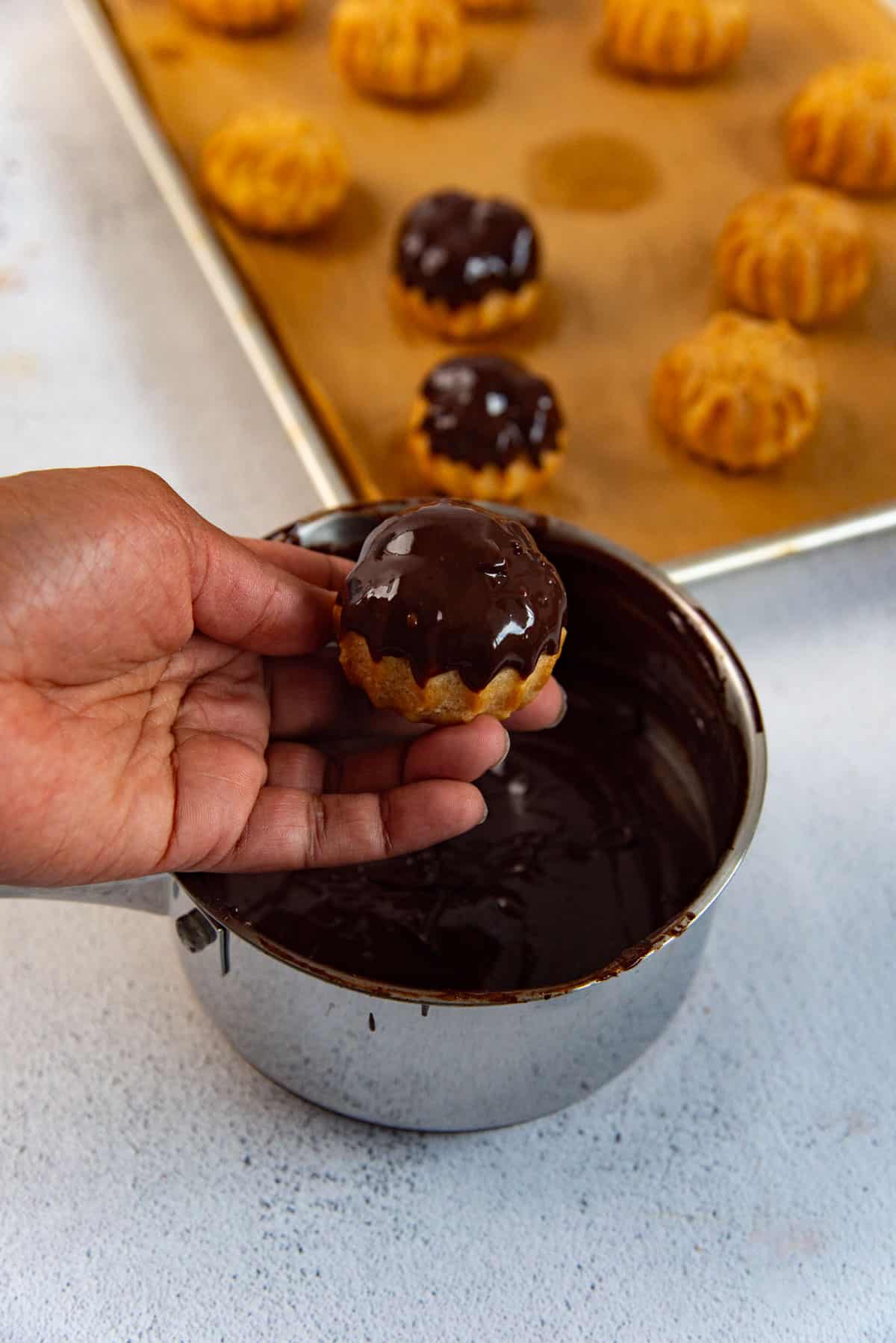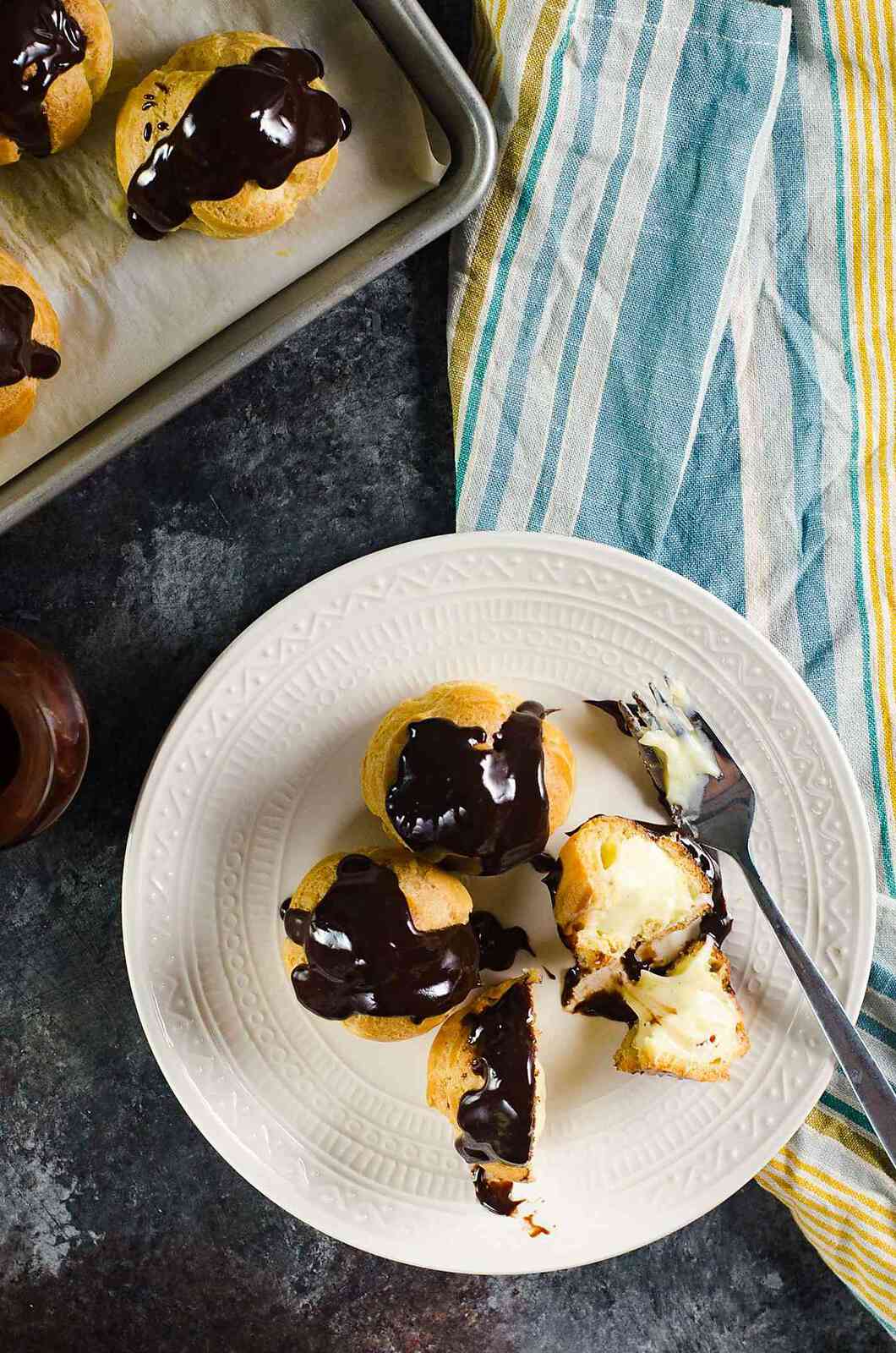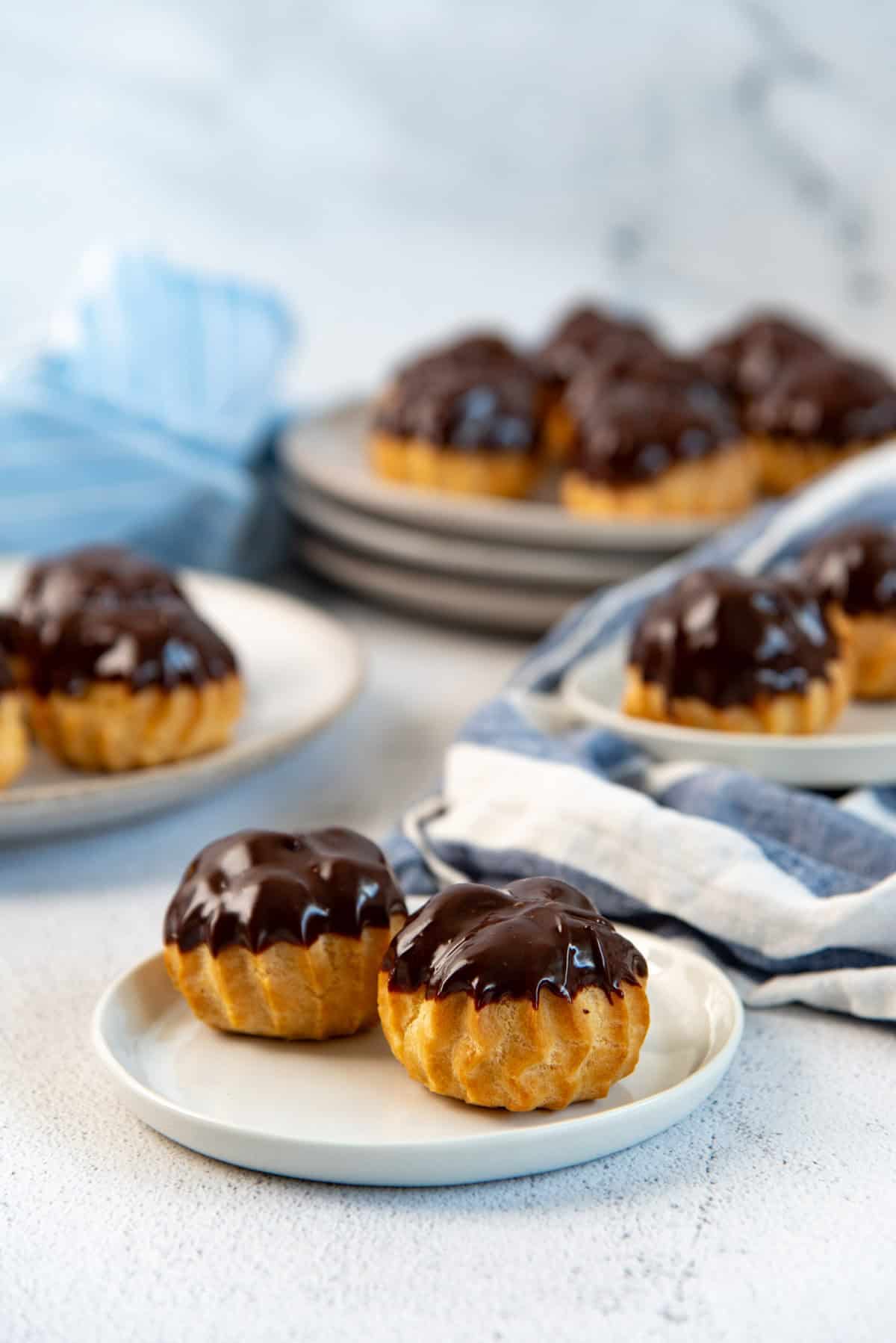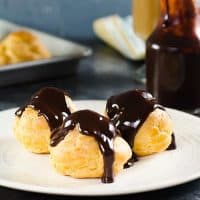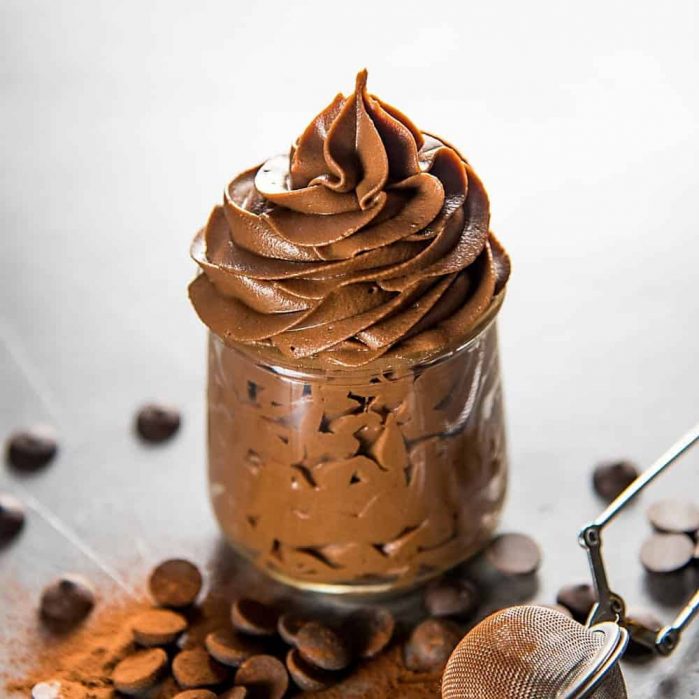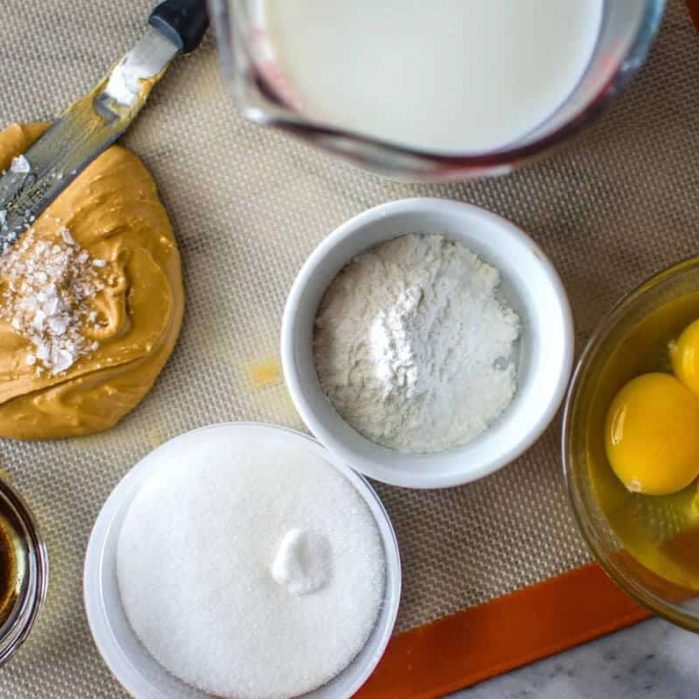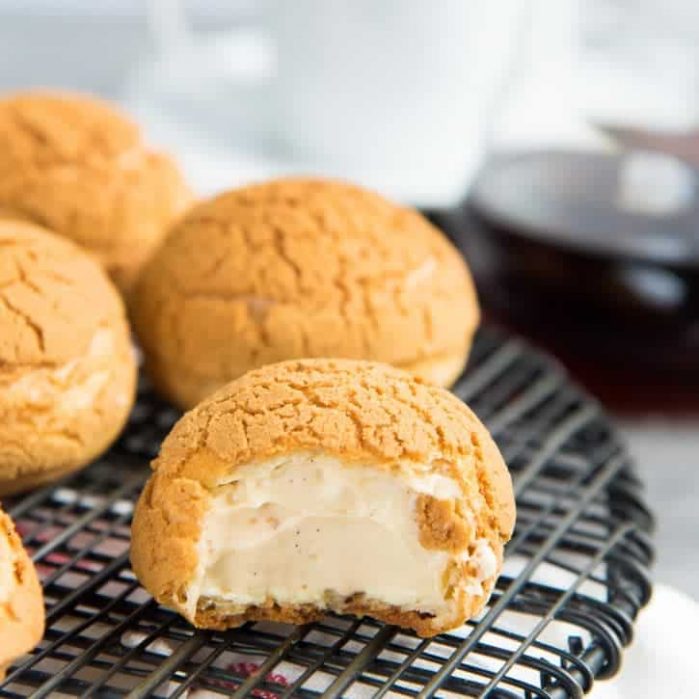Profiteroles are one of the more well known French pastries, and an easy and adaptable recipe for potlucks and parties. Serve with a mug of thick, creamy French hot chocolate for a decadent pairing. One of my most popular recipes on the blog is this choux pastry recipe with all the troubleshooting tips for making absolutely PERFECT choux pastry (pâte à choux), every single time. I’ve been making choux pastry since I was a little girl, and it’s one of my favorite easy bakes. I’ve shared a bunch of choux pastry based recipes on the blog over the years, like these classic chocolate eclairs, paris brest, cream puffs, strawberry cream puffs, chicken bouchees (chicken puffs), chouquettes (French sugar puffs), chocolate cream puffs, earl grey eclairs, choux au craquelin, coffee eclairs, pumpkin cheesecake profiteroles etc.! So, as you can tell, I LOVE anything choux pastry.
What are chocolate profiteroles?
Chocolate profiteroles are a favorite holiday dessert for many! There are 3 components to profiteroles.
Choux pastry shells Filling (pastry cream, diplomat cream, whipped cream, or ice cream) Chocolate sauce on top
So, classic chocolate profiteroles are perfectly baked choux pastry cases, usually filled with creamy creme patissiere and topped with a luscious chocolate sauce. It’s a classic and addictively delicious pastry made with simple ingredients.
Why this profiterole recipe works
I’ve shared the most comprehensive guide for making perfect choux pastry! It’s perfect for beginners, and for anyone who has had trouble perfecting their choux pastry dough. I share all the troubleshooting tips you’ll ever need for this classic French pastry. While pastry cream (crème pâtissière) is the most common filling for profiteroles, I provide recipes and other suggestions for fillings, such as whipped cream, diplomat cream, and even ice cream (simple vanilla ice cream and chocolate ice cream are two popular options). Step by step recipe instructions and tips for making the different components of this recipe and how to assemble profiteroles. I also provide storage advice and tips on how to prepare profiteroles for events.
Ingredients for chocolate profiteroles
Ingredients to make choux pastry
Water – Some recipes use water + milk, and this is absolutely OK! But I like to use just water, so that the pastry remains crisp for longer. Unsalted butter Sugar and salt (for flavor) All purpose flour Eggs Vanilla (optional)
Filling ingredients (pastry cream)
Milk Sugar Egg yolks Cornstarch Vanilla Unsalted butter Gelatin (recommended) Whipped cream (optional)
Chocolate sauce for profiteroles
Heavy cream Unsalted butter Chocolate Corn syrup (optional) Bourbon (optional)
How to make profiteroles
Pastry cream (profiterole filling)
My favorite filling options for profiteroles are either vanilla pastry cream or vanilla diplomat cream! Making the filling will be the first step, because it requires to be chilled overnight. How much filling you need will depend on how big the choux buns are. With 1 batch of choux pastry, I make about 30 pastries. One batch of my vanilla pastry cream recipe will be just enough for this many pastry cases, if you fill each pastry with about 20 g of pastry cream. But I do like to make extra pastry cream, so that I don’t run out of filling. Alternatively, you can make my diplomat cream recipe which will be more than enough for all the choux pastry cases (plus extra!). I have a step by step recipe on how to make pastry cream with absolutely no lumps, so I highly recommend reading that post so you can make perfect, rich, creamy vanilla pastry cream. Here’s a quick overview of the steps to make pastry cream, but make sure to check out my detailed post that includes pro tips for perfect pastry cream.
Choux pastry
Check out my detailed post on how to make choux pastry, which also includes troubleshooting for common choux pastry fails. Here, I will briefly outline the steps of making perfect choux pastry.
Step one – Get all the ingredients ready
The flour especially must be measured, sifted, and ready to go, because it will be added as soon as the water comes to a boil.
Step two – Melt the butter and salt in the water and bring the water to a boil
Place the water, butter, salt, and sugar (if using) in a saucepan. To make sure that the butter melts fast, cut the butter into small cubes. Stir over medium heat until the butter melts and the sugar dissolves. Once all the butter is melted, the water should come to a boil soon after.
Step three – Add the flour
As soon as the water comes to a boil, remove the pot from the heat and add the flour in one go into the water. Quickly mix the flour with the water. Mix until all the flour absorbs the water.
Step four – Cook the dough
Once you have mixed in the flour with the water, return the pot to the stove and cook the dough for just a couple of minutes while mixing the dough until it looks like thick mashed potatoes. The dough should easily form into a ball when you mix it, and there should also be a dough film on the bottom of the pan (if it’s a stainless steel pot, which won’t be seen in a non-stick pot though). If the dough is starting to get too oily, and separate, you’ve cooked the dough too long! So make sure to keep an eye on this. Remove the pot from the heat and allow the dough to cool down. Either transfer the dough into a bowl, flatten it out a little, and let it cool down naturally, OR, transfer the dough into a bowl and then use the mixer to mix it on low for a few minutes to speed up the cooling.
Step five – Add the eggs
This is a crucial step. Most recipes call for a set amount of eggs that you add to the dough. But this can cause issues with choux pastry. Having tested this dough recipe countless times, I realized that you only need to add enough eggs to get the right consistency. What does that mean? The amount of eggs you add will vary (due to other ingredients and variables), so it’s important to add the eggs a little at a time until you achieve that desired consistency! To do this, whisk the eggs in a jug to mix. For this recipe, you will need between 3 – 3.5 eggs. Add the eggs, a little at a time, and whisk it in at each addition. These are the stages to look for,
The dough will break up and be coated in eggs forming “slimy” dough pieces. Keep mixing in the eggs. Then the dough will absorb the eggs and become cohesive again. Keep adding the eggs a little at a time. When the dough becomes cohesive, the texture and appearance of the dough will change from matte and dough-like to shiny and thick paste-like. The eggs should ONLY be added until the dough just starts to become shiny. When you mix the dough with a wooden spoon or spatula and lift some of it out of the bowl, the dough should form a small V shape at the end of the spatula. Once this happens, do not add anymore eggs.
The dough is now ready! Scrape the dough into a large pastry bag, or into an airtight container with a lid. Cover the dough tightly to make sure it’s not exposed to air. Use the dough when it’s at room temperature.
Step six – Pipe the dough
For this classic profiteroles recipe, I pipe choux pastry that’s about 1.5 – 2 inches in diameter and 1 inch tall. It gives me choux pastry shells that are about 2.5 inches in diameter. I get 25 – 30 shells total with this recipe, but this will depend on how big you pipe the shells.
Choose a round tip or a French star tip to pipe the dough. The tip I use is about 1/2 inch in diameter. Choux pastry piped with a round tip will result in smoother choux pastries. When you use a French star tip, the resulting choux pastry has lines on it. Both work very well, so it’s mainly up to what you want your choux pastry to look like. Line your half sheet pan with parchment paper or silpat. This will ensure that the dough does not stick after it bakes. Keep the pastry bag at a 90 degree angle to the baking sheet. If you pipe at a smaller angle, the pastry will rise at an angle (instead of straight up). Count as you squeeze the piping bag (with consistent pressure), to ensure you pipe the same amount of dough and it’s similar in size. Dip your finger in water and then dab the tip of the choux pastry cases so that the tips are flat and smooth. Mist the baking tray with water (optional). This gives the choux pastry a little extra rise.
Step seven – Bake the dough
Bake the pastry in a preheated oven at 375 F / 191 C. During the last 5 minutes of baking, poke each pastry case once with a toothpick to allow excess steam to escape and to help dry out the choux pastry shells. The shells are done baking when they turn dark golden brown in color. Do not take them out when they are light in color because they will be extra soggy.
Step eight – Let it cool
Allow the baked choux pastry to cool down to room temperature on a wire rack before using.
Chocolate sauce
Place the ingredients in a microwave-safe bowl or small saucepan. Heat over low heat, or in small increments in the microwave. Heat only until the chocolate is almost melted (i.e. about 90% melted). Remove from the heat and stir to melt all the way through. If the chocolate is a little grainy, use a stick blender to blend the mixture. The agitation from the stick blender will make the chocolate sauce smooth and thick.
Assemble the profiteroles
Whisk the chilled pastry cream until it’s nice and smooth. Place this filling in a piping bag with a small round tip or bismarck tip. Use a small knife or small French star tip to make a hole on the bottom of the choux pastries. Fill the pastries with pastry cream. Usually, the amount of filling in each of these pastry cases should be between 17 – 22 g. But I often just go by the weight of the pastry in my hand as I fill each one. After filling all the pastries, dip the tops of the profiteroles in the warm chocolate sauce. Shake off excess sauce, and place the chocolate profiteroles on a tray to let the chocolate sauce cool down and set. Serve immediately.
How to serve these
Chocolate profiteroles are served just as they are! However, you can also add a little more liquid to the chocolate sauce and serve it as a sauce on the side. This way, guests can pour the chocolate sauce on top as they eat the profiteroles. But they are perfect this way, because they are meant to be a one-bite (or two-bite) treat.
Storage and make ahead tips
Choux pastry should be very crisp once it cools down. However, because it’s such a delicate pastry, it does lose its crispness once filled, or when stored for longer periods of time. This is why choux pastry is best served within 2 hours of being filled. But you can still make parts of this dessert ahead of time if you want to serve this at a party. The filling can be made ahead of time, and stored for up to 4 days in the fridge. The choux pastry cases can also be made ahead. One to two days in the fridge, or up to a month in the freezer. However, you will need to “freshen up” the pastries in the oven again before filling them. This will prevent the pastries from tasting stale. To make the pastries crisp and fresh again, place them on a prepared baking sheet in a single layer. Then place them in an oven preheated to 350 F, for about 5 – 10 minutes (depending on the size). Allow the shells to cool and then fill and serve.
How to store filled profiteroles
You can absolutely store filled profiteroles as well. They will still taste delicious, but will be much softer. I personally like to store the filled profiteroles in the freezer, and let them thaw out at room temperature. Freezing them keeps them tasting better for longer. The profiteroles will go stale much faster if stored in the fridge.
Recipe tips for success
Plan ahead! These pastries taste best when assembled within hours before serving. So make sure to plan everything accordingly. The pastries and filling can be made ahead of time for convenience as well. If it’s your first time making choux pastry, have a practice run. Pate a choux is so easy to make, but there are key things to look out for, and practice makes it that much easier. Check out my detailed choux pastry recipe post that has helped 1000s of readers perfect their choux pastry. Allow the choux pastry to dry out in the oven. Many people make the mistake of taking out the choux pastry too early without letting it get a little darker in the oven. This helps keep the pastry nice and puffed up, and have enough structure to hold the filling. Take your time making the pastry cream. If you rush this recipe and try to cook it on high heat, you may end up with curdled and eggy pastry cream, as I have detailed in my how to make pastry cream post. Use a stick blender to blend the chocolate sauce. This helps to keep it glossy and thick.
Frequently asked questions


